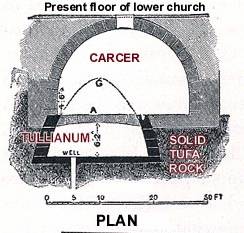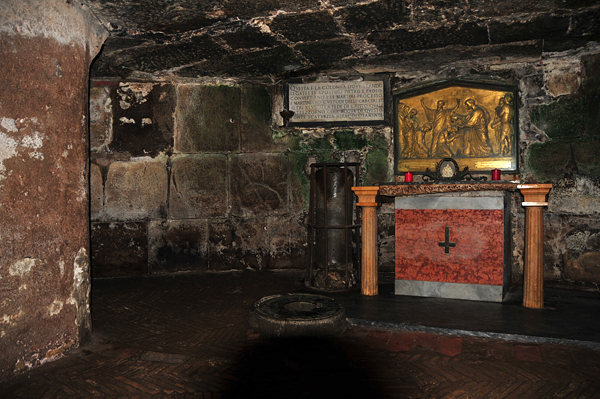St. Peter's last miracle happened in Mamertine Prison, otherwise known as the Tullianum, which is located on the east side of the Capitoline Hill, adjacent to the Roman Forum, and near the Arch of Septimius Severus, and below the church of San Giuseppe dei Falegnami. The prison consisted of two vaulted chambers, one above the other. The lower chamber is often referred to as the "Tullianum".
|
|
The name "Mamertine" is medieval in origin, and may be a reference to a nearby temple of Mars. The ancient Romans simply called the site "carcer", which is commonly translated to mean "prison". The "carcer" the only prison in the ancient city, and was reserved for important state prisoners, often prior to their execution.
"Tullianum" is from the archaic Latin tullius "a jet of water", in reference to the cistern, which it now contains and the miracle done there.
The story of Peter’s incarceration is particularly vivid. It relates that Peter pounded on the stone floor of the prison, miraculously splitting the stones and sending forth a spring of water into the chamber.
Tradition holds that after Peter miraculously made the water gush forth, he converted and baptized his two prison guards as well as 47 others while he was imprisoned there. This was St. Peter's last miracle!
Many make arguments that this miracle is just legend, but many times these "legends" turn out to be facts. Like the "legend" that St. Peter's bones were buried under St. Peter Basilica, in the Vatican, but it turned out to be true.
Regardless, even if it was legend it proves that there were many who thought that the Sacrament of Baptism was absolutely necessary, if not then why create such a "legend"?
The upper room, which is on a level that was once the ground level of the prison in ancient times, is thought to date back to the second century B.C. The walls are made of blocks of tufa on which there is mounted a plaque on which are the names of the prisons most celebrated prisoners. At the back is a small altar with busts of both Saint Peter and Saint Paul. Originally access to the lower room was gained by throwing or lowering prisoners through a hole in the floor. Nowadays for safety reasons the hole is covered b a metal grate, with access to the lower floor being gained via a set of comparatively modern steps.
The circular lower room or Tullianum, is where the condemned prisoners were thrown and sometimes strangled. Here can be seen a small altar, backed with a relief of Saint Peter baptizing his fellow prisoners. On the front of the altar, standing out against a red marble background is the upsidedown cross of St. Peter, depicting that he was crucified upsidedown. In the floor in the front of the altar is a round opening leading to the spring, the water from which it is said, Saint Peter baptised his fellow prisoners, and guards. |
|
|



